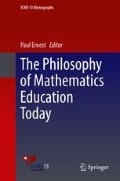Abstract
This chapter proposes that bisociation, the Koestler theory of the creativity of the “Aha!” Moment, is the Ockham Razor for creativity research in mathematics education. It shows the power of bisociation in simplifying unnecessary components and in the synthesis of the fragmented ones. The discussion leads through the relationship of bisociation with Piaget’s reflective abstraction, proposes cognitive/affective duality of the “Aha!” Moment and enriches Mason’s theory of attention by the new structure of simultaneous attention necessary for the Eureka experience.
Access this chapter
Tax calculation will be finalised at checkout
Purchases are for personal use only
References
Baker, B. (2016). Koestler theory as a foundation for problem solving. In B. Czarnocha, W. Baker, O. Dias, & V. Prabhu (Eds.), The creative enterprise of mathematics teaching-research. The Netherlands: Sense Publishers.
Bohr, N. (1935). Can quantum reality be considered complete? Physical Review, 48, 696.
Czarnocha, B. (2014). On the culture of creativity in mathematics education. Teaching Innovations, 27(3), 30–45.
Czarnocha, B. (2016). Teaching-research NY City model. In B. Czarnocha, W. Baker, O. Dias, & V. Prabhu (Eds.), The creative enterprise of mathematics teaching-research. The Netherlands: Sense Publishers.
Einstein, A., Podolsky, B., & Rosen, N. (1935). Can quantum reality be considered complete? Physical Review, 47, 777.
Eisenhart, M. (1991). Conceptual frameworks for research circa 1991: Ideas from a cultural anthropologist; Implications for mathematics education researchers. In R. G. Underhill (Ed.), 13th Proceedings of the Annual Meeting North American Chapter of the International Group for the Psychology of Mathematics Education (pp. 16–19). Blacksburg, VA: Psychology of Mathematics Education.
Gauch, H. G. (2003). Scientific method in practice. England: Cambridge University Press.
Hadamard, J. (1996). The mathematician’s mind: The psychology of invention in the mathematical field. ISBN: 0-691-02931-8.
Ilyenkov, E. (1974/2014). Dialectical logic. ISBN: 978-1-312-10852-3.
Kattou, M., Kontoyianni, K., Pantazi, D., & Christou, C. (2011). Does mathematical creativity differentiate mathematical ability? In Proceedings of the 7th Congress of European Research in Mathematics Education (p. 1056). Rzeszow, Poland: University of Rzeszów.
Koestler, A. (1964). The act of creation. London: Hutchinson.
Krathwohl, D. R. (2002). A revision of bloom taxonomy. Theory into Practice, 41(4), 212–218.
Lamon, S. (2003). Beyond constructivism: An improved fitness metaphor for the acquisition of mathematical knowledge. In R. Lesh & H. M. Doerr (Eds.), Beyond constructivism: Models and modelling perspectives on mathematics problem solving, learning and teaching (pp. 435–448). Mahwah, NJ, USA: Lawrence Erlbaum and Associates.
Leikin, R., Berman, A., & Koichu, B. (Eds.) (2009). Creativity in mathematics and the education of gifted students. Rotterdam, the Netherlands: Sense Publisher.
Lester, F. K., Jr. (2010). On the theoretical, conceptual, and philosophical foundations for mathematics education research in mathematics education. In B. Sriraman & L. English (Eds.), Theories of mathematics education: Seeking new frontiers (pp. 67–86). Berlin, Heidelberg: Spring.
Liljedahl, P. (2013). Illumination: An affective experience. The International Journal of Mathematics Education, 45, 253–326.
Mann, E. L. (2005). Mathematical creativity and school mathematics: Indicators of mathematical creativity in middle school students. Doctoral Dissertation. Connecticut: University of Connecticut.
Mason, J. (2008). Being mathematical with and in front of learners: Attention, awareness, and attitude as sources of differences between teacher educators, teachers and learners. In B. Jaworski & T. Wood (Eds.), The mathematics teacher educator as a developing professional (pp. 31–56). Rotterdam/Taipei: Sense Publishers.
Naglieri, J. A., & Das, J. P. (1997). Simultaneous processing is engaged when the relationship between items and their integration into whole units of information is required. In Das-Naglieri cognitive assessment system. Itasca, IL, USA: Riverside Publishing.
Piaget, J., & Roland, G. (1987). Psychogenesis and the history of science. New York: Columbia Press.
Prabhu, V. (2016) Unit 2 Creative Learning Environment. In B. Czarnocha, W. Baker, O. Dias & V. Prabhu (Eds.), The Creative Enterprise of Mathematics Teachhing Research. Sense Publishers, 2016.
Prabhu, V., & Czarnocha, B. (2014). Democratizing mathematical creativity through koestler’s bisociation theory. In S. Oesterle, P. Liljedahl, C. Nicol, & D. Allan (Eds.), Proceedings of the Joint Meeting of PME 38 and PME-NA 36 (Vol. 3). Vancouver, Canada: PME.
Riquelie, F., & de Schonen, S. (1997). Simultaneous attention in the two visual hemifields and interhemispheric integration: A developmental study on 20–26 months old infant. Neuropsycholgia, 35(2), 380–385.
Sfard, A. (1995). The development of algebra: Confronting historical and psychological perspectives. Journal of Mathematic Behavior, 14, 15–39.
Sriraman, B. (2005). Are giftedness and creativity synonyms in mathematics? The Journal of Secondary Gifted Education, 17(1), 20–36.
Sriraman, B., Yaftian, N., & Lee, K. H. (2011). Mathematical creativity and mathematics education: A derivative of existing research. In Sriraman & Lee (Eds.), The elements of creativity and giftedness in mathematics. Holland: Sense Publishers.
Stenhouse, L. (1975). An introduction to curriculum research and development. London: Heinemann.
Torrance, E. P. (1974). Torrance tests of creative thinking. Bensenville, IL, USA: Scholastic Testing Service.
Von Glasersfeld, E. (1989). Cognition, construction of knowledge, and teaching. Synthese, 80(1), 121–140.
Wallas, G. (1926). The art of thought. New York: Harcourt Brace.
Weisberg, R. W. (1995). Prolegomena to theories of insight. In R. Sternberg & J. Davidson (Eds.), The nature of insight (3rd ed.). Cambridge, MA: MIT Press.
Author information
Authors and Affiliations
Corresponding author
Editor information
Editors and Affiliations
Rights and permissions
Copyright information
© 2018 Springer International Publishing AG, part of Springer Nature
About this chapter
Cite this chapter
Czarnocha, B., Baker, W., Dias, O. (2018). Creativity Research in Mathematics Education Simplified: Using the Concept of Bisociation as Ockham’s Razor. In: Ernest, P. (eds) The Philosophy of Mathematics Education Today. ICME-13 Monographs. Springer, Cham. https://doi.org/10.1007/978-3-319-77760-3_20
Download citation
DOI: https://doi.org/10.1007/978-3-319-77760-3_20
Published:
Publisher Name: Springer, Cham
Print ISBN: 978-3-319-77759-7
Online ISBN: 978-3-319-77760-3
eBook Packages: EducationEducation (R0)

